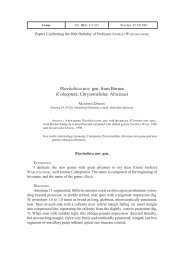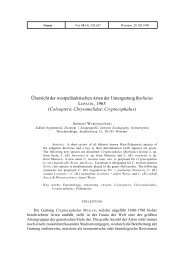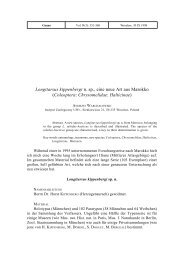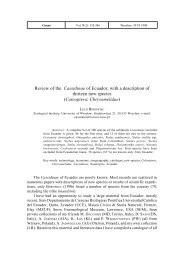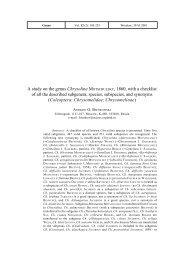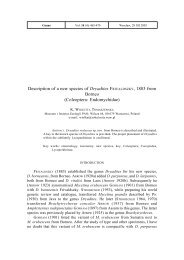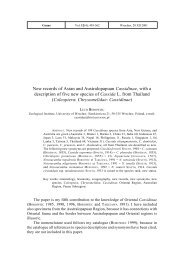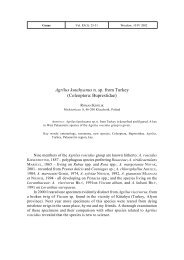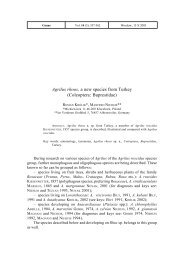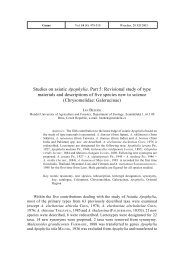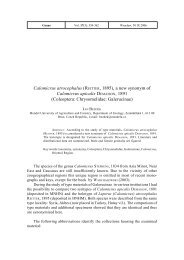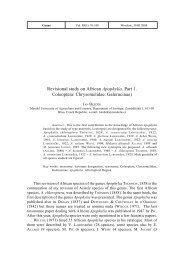New Alticinae from China and southeastern Asia (Coleoptera ...
New Alticinae from China and southeastern Asia (Coleoptera ...
New Alticinae from China and southeastern Asia (Coleoptera ...
You also want an ePaper? Increase the reach of your titles
YUMPU automatically turns print PDFs into web optimized ePapers that Google loves.
NEW ALTICINAE FroM CHINA AND SouTHEASTErN ASIA<br />
279<br />
antennae piceous, the latter with segments 1-3 <strong>and</strong> 10-11 reddish-brown, the basal segment<br />
of antennae upside blackish. ocular furrows lacking, frontal lines deeply incised,<br />
forming a sharp angle in the centre; frontal calli long <strong>and</strong> narrow, sharply bordered,<br />
separated one <strong>from</strong> the other by the upper end of frontal ridge. The latter before the<br />
antennal sockets short <strong>and</strong> sharply edged. Antennae reaching the apex of elytra; proportions<br />
of antennal segments in holotype are as 23:12:19:26:28:28:31:34:33:34:48<br />
(1 = 0.01 mm); the second segment but a little more thickened <strong>and</strong> a littler shorter<br />
than the third one. Frons <strong>and</strong> vertex smooth <strong>and</strong> shining, only on both sides with a fine<br />
setiferous pore near the eyes.<br />
Pronotum 1.2 times as broad as long, smooth <strong>and</strong> shining, broadest in anterior part,<br />
somewhat emarginated before the hind corners; anterior corners obliquely truncate,<br />
posterior corners <strong>and</strong> basal margin widely arched, the corners only marked by a sharp<br />
tooth. The disc in posterior half distinctly punctate, but more scattered than elytra.<br />
Scutellum trigonate, smooth <strong>and</strong> shining. Elytra distinctly, densely <strong>and</strong> confusedly<br />
punctate throughout; distance between the points of their own diameter; humeral calli<br />
protruding. Hind tibiae dorsally flattened, without a keel; spur short.<br />
Sexual dimorphism: In ♂♂, sides of the first segment of anterior <strong>and</strong> mid tarsi<br />
curved, <strong>and</strong> as broad as the third one; in ♀♀, sides of first segment of fore <strong>and</strong> mid<br />
tarsi straight, <strong>and</strong> narrower than the third one. Aedeagus <strong>and</strong> spermatheca as in Figs.<br />
25-27).<br />
discussion<br />
I consider L. fuscorufus n. sp. similar to L. zhamicus chen & Wang, 1981: 503,<br />
508, known to me only <strong>from</strong> its description. L. zhamicus is differently punctate on elytra<br />
(“having a certain degree of arrangement in longitudinal striae”), but also differently<br />
coloured (yellow-brown, antennae, front <strong>and</strong> middle legs paler, straw-yellow).<br />
distribution<br />
<strong>China</strong> (Yunnan).<br />
Longitarsus neckeri nov. spec.<br />
Figs. 28-30<br />
etyMology<br />
Named in honour of my deceased friend Georg Necker. He was my dear comrade<br />
in numerous excursions.<br />
Material<br />
Holotype (♂): Nord Indien, uttar Pradesh, Badrinat, 3.200-3.600 m, 1. viii. 1989,<br />
leg. A. riedel (MDGC). Paratypes: 3 ♂♂, 5 ♀♀ dito; 2 ♀♀ Nord Indien, Himachal<br />
Pradesh, Bimla Kufri, 16. vii. 1989, leg. riedel; 1 ♂ Himachal Pradesh, Manali, Solang<br />
Valley, 2.500 m leg. riedel; 9 ♂♂ 1 ♀ Nord Indien, Danolti nr. Mussoorie, 4. ix. 1987,<br />
leg. riedel (MBFC, MDGC, NHMG, uSNM, IZAS).



